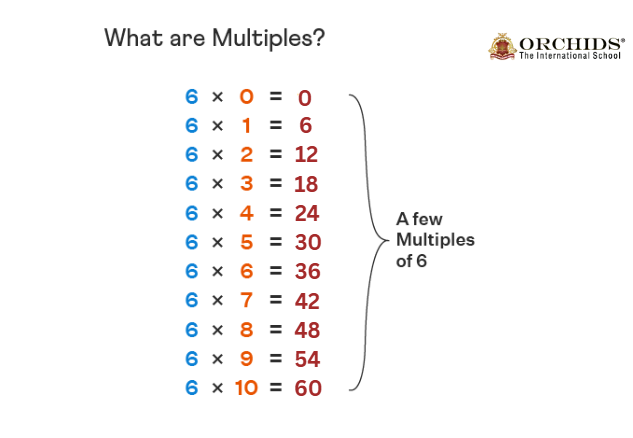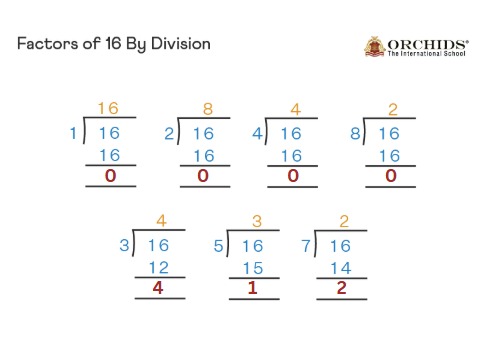Factors and Multiples Class 4 [+12 Worksheets]
This is a comprehensive lesson plan for teaching factors and multiples to grade 4 students.The lesson is designed to make the concepts easy and engage students with activities like quizzes, practice questions, and worksheets.
Teachers can use this guide as a reference for delivering the concepts to students and engaging them in the classroom with the various questions and examples given in this page.
For parents, there are 12 downloadable practice worksheets that they can use for their kids.
In this blog, you will learn
- the definitions of factors and multiples along with examples.
- what are factor pairs, common factors, GCF or Greatest Common Factors with examples.
- what are multiples and determining if a number is a multiple.
What Are Factors?
Factors are numbers that, when multiplied together, make a product. That is to say, if you multiply two numbers, the two numbers you used are factors of the product.
Example : Consider the number 12. What are the factors of 12?
- 1 × 12 = 12
- 2 × 6 = 12
- 3 × 4 = 12
Thus, factors of 12 are 1, 2, 3, 4, 6, and 12.
Know how to calculate factors of 24 here.
What Are Factor Pairs?
A factor pair is a pair of factors whose product is the same. For instance, the following are the factor pairs for 12:
- (1, 12)
- (2, 6)
- (3, 4)
Every two numbers can be multiplied to give 12.
Interesting Fact:
The smallest factor of any number is always 1, and the greatest factor is the number itself. For example, the smallest factor of 12 is 1, and the largest factor is 12.
What Are Common Factors?
Common factors are any numbers that divide two or more numbers without any remainder. Common factors are the common divisors of two or more numbers. To find common factors we make a list of each number's factors and then determine which factors appear on both lists.
Example: Finding Common Factors of 12 and 18
- Factors of 12 : 1, 2, 3, 4, 6, 12
- Factors of 18: 1, 2, 3, 6, 9, 18
- Common numbers on both lists: 1, 2, 3, and 6.
- So, the common factors of 12 and 18 are: 1, 2, 3, and 6.
GCF (Greatest Common Factor)
The common factors and the greatest common factor is the largest number in the list of common factors. In the previous example, it is 6. When we work with the GCF, we are able to simplify fractions and solve problems like dividing things into equal groups (described below).
How Do Common Factors Help Us?
- We use common factors to simplify fractions and solve problems such as dividing things into equal groups.
- Simplifying fractions: To simplify fractions we divide both top and bottom by their greatest common factor.
- For instance, 12 and 18 can be divided by 6, resulting in 2 and 3 respectively.
Dividing into Equal Groups
If you have 24 apples and 36 oranges and want to divide the fruit into the largest number of equal groups, the common factors of 24 and 36 will assist you. Through the greatest common factor, you will be able to make 12 equal groups.
Word Problems:
Using common factors often helps to solve everyday problems such as equally sharing a number of candies. Assuming you have 18 candies and 6 people: there is a common factor among 18 and 6, which is 6. Therefore each person received 3 candies.
Examples of Common Factors:
- Factors of 8 and its common factors of 12
- Factors of 12: 1, 2, 3, 4, 6, 12
- Common factors: 1, 2, and 4. The highest common factor is 4.
Common Factors of 20 and 30:
- Factors of 20: 1, 2, 4, 5, 10, 20
- Factors of 30: 1, 2, 3, 5, 6, 10, 15, 30
- Common factors: 1, 2, 5, and 10. The highest common factor is 10.
How to Find Common Factors
- List the factors: Write down the factors of each number.
- Find the common ones: Find a number that occurs in both lists.
- Choose the largest: The greatest common number is the greatest common factor (GCF).
What Are Multiples?
A multiple is a number you get by multiplying a number by 1, 2, 3, 4, and so on.

Example: Let's find the first few multiples of 4. We multiply 4 by 1, 2, 3, 4, and so on:
- 4 × 1 = 4
- 4 × 2 = 8
- 4 × 3 = 12
- 4 × 4 = 16
- 4 × 5 = 20
So, the multiples of 4 are 4, 8, 12, 16, 20, and so on.
Determining if a Number is a Multiple
To check if one number is a multiple of another, divide the first number by the second number. If the division results in a whole number (no remainder), then the first number is a multiple of the second.
Example :
- Is 24 a multiple of 6?
- 24 ÷ 6 = 4 (No remainder)
- Since the division results in a whole number 4 hence, 24 is a multiple of 6.
Fun Fact:
Do you know? The smallest multiple of any number is that number itself. Take the smallest multiple of 7 - it's 7; Take the smallest multiple of 10 - it's 10.
Orchid's learning material
Click the button to download the e-book
FAQs
1. How do you explain factors & multiples to a child?
Factors are numbers you can multiply together to achieve a product. Multiples are results you get after multiplying any number by 1, 2, 3, and more. Take the case of 6 and its factors as 1, 2, 3, 6. Likewise, a multiple of 6 means 6, 12, 18, etc.
2. What is a math multiple?
Multiples are those numbers that you get from the multiplication of a number by whole numbers (1, 2, 3, etc.). So, the multiples of 4 are 4, 8, 12, 16, and many more. A multiple of a number keeps growing, adding that number repeatedly.
3. Is 8 a factor and multiple?
Yes, 8 is a multiple and a factor. The numbers are 16 and 24 because 8 × 2 = 16, 8 × 3 = 24. It is also a multiple of itself. A multiple of 8 is: 8, 16, 24, 32, 40 and so on.
4. What is the definition of a factor in mathematics?
A factor is a number that divides another number without leaving a remainder. For example, the factors of 12 are 1, 2, 3, 4, 6, and 12. Factors are the building blocks that multiply together to form a product.
Things you have learned!
- Factors, factor pairs, common factors and GCF or Greatest Common factors
- How to find common factors and how they help us
- What are multiples and determining if a number is a multiple
CBSE Schools In Popular Cities
- CBSE Schools in Bangalore
- CBSE Schools in Mumbai
- CBSE Schools in Pune
- CBSE Schools in Hyderabad
- CBSE Schools in Chennai
- CBSE Schools in Gurgaon
- CBSE Schools in Kolkata
- CBSE Schools in Indore
- CBSE Schools in Sonipat
- CBSE Schools in Delhi
- CBSE Schools in Rohtak
- CBSE Schools in Bhopal
- CBSE Schools in Aurangabad
- CBSE Schools in Jabalpur
- CBSE Schools in Jaipur
- CBSE Schools in Jodhpur
- CBSE Schools in Nagpur
- CBSE Schools in Ahmednagar
- CBSE School In Tumkur












